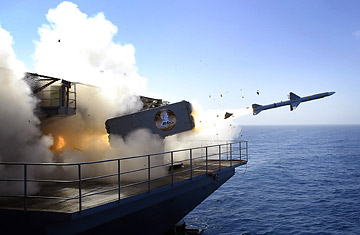
A missile launches from a US Navy warship.
In a week in which Russia and China called for a treaty banning weapons in space, the Pentagon has announced it has orders from President Bush to shoot down a secret spy satellite — but the satellite in question is an American vessel, and its being targeted for destruction before it tumbles back to Earth next month and potentially spews a deadly chemical.
The U.S. hasn't tried shooting a satellite since President Reagan's heyday, in 1985 (it succeeded). And Washington complained loudly, early last year, after China successfully completed its first such test, blasting one of its own old weather satellites to bits. "The U.S. believes China's development and testing of such weapons is inconsistent with the spirit of cooperation that both countries aspire to in the civil space area," National Security Council spokesman Gordon Johndroe said at the time. "We and other countries have expressed our concern regarding this action to the Chinese."
But this time around, the U.S. is playing defense instead of offense. Pentagon officials say the 5,000-pound satellite will be taken out by a specially modified missile fired from a Navy warship. The satellite, launched in December 2006, never became operational. It is more than twice the weight of the 2,200-pound Chinese satellite, which spewed thousands of pieces of debris across a wide swath of space.
"Based on modeling and analysis, our officials have high confidence that the engagement will be successful," the Pentagon said in a statement. "As for when this engagement will occur, we will determine the optimal time, location, and geometry for a successful engagement based on a number of factors." The optimum time is likely to occur at the end of this month or in early March.
The Lockheed-Martin satellite is carrying 1,000 pounds of hydrazine, a toxic fuel used to power thrusters that steer the satellite while in orbit. If the tank remains intact as the satellite falls to Earth — about half its weight is expected to survive reentry — it could rupture and kill anyone nearby, U.S. officials say. But the satellite's projected landing area is 70% water, and there are other factors that undoubtedly influenced the decision to shoot down the satellite. The firing will allow the U.S. to test its fledgling anti-missile system, as well as signaling to other nations Washington's ability to down satellites 23 years after it conducted its last such test of that capability. One more bonus of blowing the thing up in space: it eliminates any danger of the top-secret technologies on board falling into the wrong hands should the satellite land in Iran, North Korea, or China.
What if the U.S. misses? Not to worry, says the Pentagon. "In the event the engagement is not successful, all appropriate elements of the U.S. government are working together to explore options to mitigate the danger to humans and to ensure that all parties are properly prepared to respond," it said. "In the unlikely event satellite pieces land in a populated area, people are strongly advised to avoid the impact area until trained hazardous materials teams are able to properly dispose of any remaining hydrazine."
